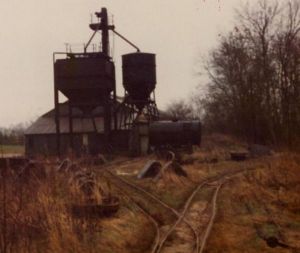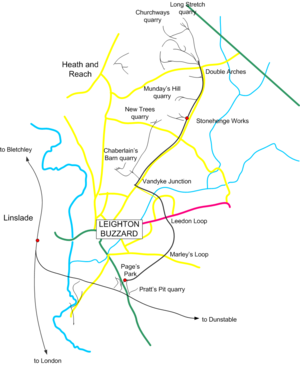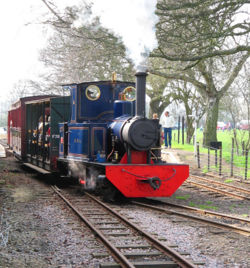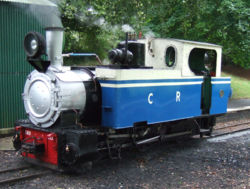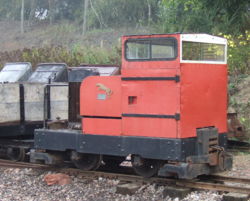Leighton Buzzard Light Railway
| Leighton Buzzard Light Railway | |
|---|---|
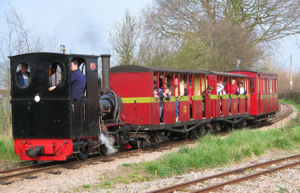
| |
| A train on the LBLR being pulled by no. 11 PC Allen | |
| Location | |
| Place | England |
| Terminus | Leighton Buzzard |
| Commercial Operations | |
| Name | Leighton Buzzard Light Railway |
| Built by | A.J. Arnold and G. Garside |
| Gauge | 2 ft (610 mm) |
| Preserved Operations | |
| Operated by | Leighton Buzzard Narrow Gauge Railway Society |
| Stations | 6 |
| Length | 3 miles |
| Gauge | 2 ft (610 mm) |
| Commercial History | |
| Opened | 1919 |
| Closed | 1969 |
| Preservation History | |
| 1968 | First pasenger trains run by preservation society |
The Leighton Buzzard Light Railway (LBLR) is a narrow-gauge light railway in the town of Leighton Buzzard in Bedfordshire, England. It operates on a 2 ft (610 mm) gauge, and is just under 3 miles (4.8 km) in length. The line was built just after the First World War to serve the many sand quarries to the north of the town. In the late 1960s the sand quarries switched to road transport and the railway was taken over by a group of volunteers who now run the line as a heritage railway.
Contents
History
Sand extraction
A bed of Lower Cretaceous sand runs across Bedfordshire and these have been quarried on a small scale for several centuries. The most significant quarries occur around the town of Leighton Buzzard. In the 19th century sand was carried by horse-drawn carts from the quarries south of the town to be shipped on the Dunstable-Leighton Buzzard railway. These carts caused considerable damage to the roads of the district and resulted in claims for compensation against the quarry owners from the Bedfordshire County Council. At the end of the century steam wagons were introduced which increased the damage to roads.
The outbreak of the First World War meant that sand supplies of foundry sand from Belgium were cut off. Sand was needed for the British ammunition factories and new sources of high quality sand were sought. Leighton Buzzard sands proved well suited to these needs and production in the region increased dramatically.
After the war ended in 1919 the quarry companies were told they could no longer transport their product over local roads, so a private industrial railway was proposed to take the traffic.
The original railway
The Leighton Buzzard Light Railway opened on Thursday November 20, 1919, linking the sand quarries with the mainline railway to the south of the town. The line was originally built using surplus equipment obtained from the War Department Light Railways. The line opened using steam traction provided by two Hudswell Clarke steam locomotives. These proved inappropriate for the tightly-curved line and the steam locomotives were sold in 1921. From the point on the railway was run entirely using internal combustion locomotives, almost exclusively the products of the Motor Rail company. It was one of the first railways in Britain to be entirely operated by internal combustion locomotives.
After the Second World War sand traffic began to return to the road system. In 1953 a strike on the mainline railways pushed more traffic onto the roads. By the mid-1960s only one of the sand quarry comapnies, Arnold's, still used the light railway to carry sand.
The preservation era
In 1968 the line was much more lightly used, and volunteers took over the line on weekends to run passenger trains; these were the first formal passenger services to run on the line. The last sand train ran on the main line in 1969, although several of the quarries continued to used the rail lines within their quarries. These too were eventually replaced by roads and conveyor belts and the last internal quarry line was abandoned in 1981. Today the line is run purely as a heritage railway.
A large collection of steam and internal combustion locomotives run on the line. There is a significant collection of historic industrial railway locomotives on display at Stonehenge Works at the northern end of the line.
The route
The line is somewhat unusual as it runs mostly through a modern housing estate, which was built in the 1970s, although the last half mile of the line runs through countryside. There are a number of open level crossings for which trains have to stop.
The railway began at the Grovesbury Sidings, where sand trains unloaded into a series of washers and the sand was transshipped to either standard gauge trains on the Dunstable branch or to road. The complex of sidings and industrial plant at Grovesbury was replaced with an industrial estate in the early 1970s.
Trains from Grovesbury crossed the Billington Road by a level crossing and worked up a steep grade to Page's Park. Here a branch line to the south connected to the line's main engineering workshop and the Pratt's Pit quarry. In 2006 Page's Park forms the southern terminus of the heritage railway.
From Page's Park the line curves to the north towards a summit at Red Barn. From there it descends at at gradient of 1 in 60 before climbing again to cross Stanbridge Road, past which is a loop where trains can cross. On the left is the site of Marley's Tile Works which was connected to the railway for most of its existence. The line then descends Marley's Bank at a maximum gradient of 1 in 25. Loaded sand trains running to Grovebury Sidings would often need an additional banking locomotive to climb this incline.
At the bottom of Marley's Bank the line turns sharply north and runs along the level to Leedon Loop. The line here is passing through a housing estate built in the mid 1970s. After leaving Leedon, the railway crosses the Hockliffe Road and crosses the Clipstone Brook and begins to climb again on a 1 in 50 gradient to cross the Vandyke Road.
Immediately after crossing the Vandyke Road the line curves sharply through 90 degrees to Vandyke Junction where there is a passing loop. Here the branch line from Chamberlain's Barn and New Trees quarries joined the main line. A short section of this branch remains intact although heritage trains do not use it. The railway then runs parallel to the Vandyke Road, climbing steadily to a summit at Bryan's Loop and then descending again to cross the Shenley Hill Road. The line levels and continues to Stonehenge Works now the main engineering workshop of the preserved railway. This is also the northern terminus of modern operations.
From Stonehenge the line continues northwards with a mile-long section of double track, climbing towards the two Double Arches sand quarries, owned by Joseph Arnold and George Garside.
Preserved locomotives
These are the locomotives operating on the preserved railway
Steam locomotives
| Number | Name | Builder | Type | Works Number | Built | Origin | Notes |
|---|---|---|---|---|---|---|---|
| 1 | Chaloner | De Winton | 0-4-0 VB | n/a | 1877 | Penyrorsedd slate quarry, north Wales | Worked at the Penybryn quarry until 1897 then Penyrorsedd until 1960. Purchased by Alfred Fisher and transferred to Leighton Buzzard in 1968. |
| 2 | Pixie | Kerr Stuart | 0-4-0 ST | 4260 | 1922 | Devon County Council, Wilminstone Quarry | One of 27 of the Wren class ordered for a sewer contract in Essex, sold to Devon County Council in 1929. Purchased by the Industrial Locomotive Society in 1957; entered service at Leighton Buzzard in 1969. Now at the Devon Railway Centre. |
| 3 | Rishra | Baguley | 0-4-0 T | 2007 | 1921 | Hoogly Docking & Engineering Co., Rishra, India | The only remaining locomotive of this type in existence. Purchased by Mike Satow in 1963 and repatriated to Leighton Buzzard. Entered service in 1971. |
| 4 | Doll | Andrew Barclay | 0-6-0 T | 1641 | 1919 | Sydenham Ironstone Quarry, King's Sutton, Oxfordshire | Transferred in 1926 to Bilston Furnaces where it ran until 1960. Purchased by the Bressingham Steam Museum in 1966; sold to Henry Williams in 1969; purchased by the Leighton Buzzard Light Railway in 1972. |
| 5 | Elf | Orenstein & Koppel | 0-6-0 WT | 12740 | 1936 | Likomba Development Company, Cameroon, Africa | Purchased in 1973 after serving in Cameroon until 1971. Wood burning locomotive with a spark arrestor. |
| 6 | Alice | Hunslet | 0-4-0 ST | 780 | 1902 | Dinorwic slate quarry | Now running at the Bala Lake Railway |
| 11 | PC Allen | Orenstein & Koppel | 0-4-0 WT | 5834 | 1913 | Solvay Alkali Works, Torrelarega, Spain | Purchased by Sir Peter Allen in 1963, transferred to Leighton Biuzzard in 1970. |
| Berlin | Freudenstein | 0-4-0 WT | 73 | 1901 | Penlee quarry, Newlyn, Cornwall | Arrived at LBLR in 1991 | |
| 9 | Peter Pan | Kerr Stuart | 0-4-0 ST | 4256 | 1922 | Devon County Council, Willminstone Quarry, Devon | Wren class locomotive that worked with Pixie in Devon. Purchased in 1972 by Graham Hall who found the locomotive in a back garden in Bromsgrove. |
| 778 | Baldwin Locomotive Works | 4-6-0 T | 44656 | 1917 | War Department Light Railway | Undergoing restoration | |
| 740 | Orenstein & Koppel | 0-6-0 T | 2343 | 1907 | Matheran Light Railway, Maharastra, India | Recently restored to working order, has rare Kleiner-Lindex radial axles |
Internal combustion locomotives
| Number | Name | Builder | Type | Works Number | Built | Origin | Notes |
|---|---|---|---|---|---|---|---|
| (1) | Motor Rail | 4wDM | 5612 | 1931 | St. Albans Sand and Gravel Co. Lts. Nazeing, Essex | Dismantled by 1988 | |
| (2) | Motor Rail | 4wDM | 5608 | 1931 | St. Albans Sand and Gravel Co. Lts. Smallford, Hertfordshire | Converted to a brakevan, c. 1970 | |
| (3) | Motor Rail | 4wDM | 5613 | 1931 | St. Albans Sand and Gravel Co. Lts. Smallford, Hertfordshire | Converted to a crane, c. 1970 | |
| 6 | Caravan | Motor Rail | 4wDM | 7129 | 1938 | Redland Flettons Brick Company | An unusual variant of the Motor Rail Simplex class with an overall cab. |
| 7 | Falcon (Pam until c. 1978) | Orenstein & Koppel | 4wDM | 8986 | unknown | Woodham Brick Co. Ltd., Wotton, Buckinghamshire | Only surviving member of the MD2 class in Britain. Rescued from a Newport Pagnell scrapyard in 1970 by Peter Hodges. |
| 8 | Gollum | Ruston Hornsby | 4wDM | 217999 | 1942 | Featherby's Brickworks, Rochford, Essex | |
| 9 | Madge | Orenstein & Koppel | 4wDM | 7600 | 1935 | Oxstead Grestone Lime Co. Ltd., Oxstead, Surrey | Single cylinder RL1C class |
| 10 | Haydn Taylor | Motor Rail | 4wDM | 7956 | 1945 | British Industrial Sand Ltd. Middelton Towers, Norfolk | Originally loaned by its owners in 1971. Nicknamed "Breadbin" due to its unusual cab shape. Rebuilt in 1973 with a conventional cab. |
| 12 | Carbon | Motor Rail | 4wPM | 6012 | 1930 | Standard Bottle Co., New Southgate, Middlesex | Arrived in 1972 via M.E. Engineering, Cricklewood. |
| 13 | Arkle | Motor Rail | 4wDM | 7108 | 1937 | George Garside, Leighton Buzzard, Bedfordshire | Original Leighton Buzzard sand quarry loco, operated until 1981 |
| (14 | Hunslet | 4wDM | 3646 | 1946 | Crumbles Gravel Pits, Eastbourne, Sussex | Arrived 1972 | |
| 15 | Tom Bombadil (after 1990) | F.C. Hibberd | 4wDM | 2415 | 1941 | Butterley & Blaby Brick Companies Lts., Ripley, Derbyshire | |
| 16 | Thorin Oakenshield | Lister | 4wPM | 11221 | 1939 | Gaurdbridge Paper Co. Ltd., Leuchars, Fife | |
| 17 | Damredub | Motor Rail | 4wPM | 7036 | 1936 | George Garside, Leighton Buzzard, Bedfordshire | Original Leighton Buzzard sand quarry loco, operated until 1981 |
| 18 | Feanor | Motor Rail | 4wDM | 11003 | 1956 | British Industrial Sands Ltd., Middleton Towers, Norfolk | |
| 19 | Motor Rail | 4wDM | 11298 | 1965 | British Industrial Sands Ltd., Middleton Towers, Norfolk | ||
| 20 | Motor Rail | 4wDM | 60S317 | 1966 | British Industrial Sands Ltd., Middleton Towers, Norfolk | ||
| 21 | Festoon | Motor Rail | 4wPM | 4570 | 1929 | George Garside, Leighton Buzzard, Bedfordshire | Original Leighton Buzzard sand quarry loco, preserved 1981 |
| 22 | Fingolfin | LBLR | 4wDM | 1 | 1989 | Constructed from parts of Ruston Hornsby 425798 and 444207 | |
| 23 | Ruston Hornsby | 4wDM | 164346 | 1932 | West Kent Main Sewage Board, Littlebrook, Kent | Second oldest Ruston Hornsby locomotive in existence | |
| 24 | Motor Rail | 4wDM | 11297 | 1965 | British Industrial Sands Ltd., Middleton Towers, Norfolk | ||
| (24) | Motor Rail | 4wPM | 4805 | 1934 | J. Arnold & Sons Ltd., Leighton Buzzard, Bedfordshire | Original Leighton Buzzard sand quarry loco, dismantled by 1980 | |
| 43 | Motor Rail | 4wDM | 10409 | 1954 | Leighton Buzzard Light Railway Company, Leighton Buzzard, Bedfordshire | Original LBLR mainline locomotive; purchased by John Cohring in 1972 |
References
- Leleux, Sydney (1996). The Leighton Buzzard Light Railway, 2nd edition, The Oakwood Press. ISBN 0-85361-460-1.
- Hughes D.N.R. et al. (1974). Leighton Buzzard Narrow Gauge Railway Guide. Leighton Buzzard Narrow Gauge Railway Society Ltd..
See also
External links
